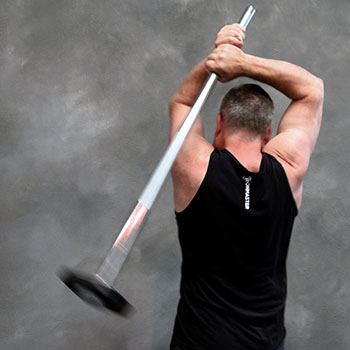Blog
Why you need to start mace training, today!
Mace training is an easy and hugely beneficial add to your home gym routine, here's why.
In ancient times, men met on the field of battle with all manner of deadly armament. The sword, the battleaxe, the war-hammer, and the heavy mace were common tools for utterly demolishing the enemy.

But another thing these weapons did well was endow the user with unbelievable core strength and shoulder mobility.
In our modern world, this is what we seek from weapons like these, far more than the most efficient way of making someone’s head look like a dropped cantaloupe.
For this purpose, the mace is superior to the sword or war hammer because you can quickly and easily adjust the weight. Enter Ironmaster’s all-new Quick-Lock Mace Handle, the perfect fully-adjustable tool for both warming up and mace-specific training.
Who Benefits from Mace Training
Short of saying “everybody!” and leaving it at that, there are a few demographics for whom mace training offers a high degree of benefit. These are the rotational sports: hockey, golf, tennis, lacrosse, baseball, and softball. Basically any sport where you SWING something.
This is because mace training focuses on building core strength, stability, and power on BOTH sides of your body.
On some level, muscular imbalances are inevitable in these sports. But, while it may seem like they wouldn’t affect your performance too much (“I mean, if my right side is jacked and my left side is tiny, what’s the big deal if I always throw with my right?”), this is a fallacy, as muscular imbalances often lead to movement imbalances, compensations, and ultimately injuries, stunting progress. And who needs that?
Mace training helps minimize the impact of muscular imbalances and keeps you healthy and functional for higher performance in your sport.
Warmups and Preparation
For starters, mace training incorporates a broad spectrum of movements that fit perfectly into your strength training warmup. In fact, you could use mace training exclusively for this purpose and derive a ton of benefits from it.
Of course, mace training can also become a primary fitness activity or skill unto itself. Like kettlebell training, or any training modality really, proper warmups are essential for safety and effectiveness, as is putting aside the ego when it comes to shoulder mobility.
For this reason, warmups usually include some stretching of the shoulders plus some introductory movements. The main muscles to be stretched are the shoulders, the upper chest, the triceps, and the lats.
As for warmup exercises, there are two kettlebell movements that also function perfectly as regressions for someone just starting out with mace training. They can also be done with a single dumbbell.
The movements are the Halo and the Ribbon. They both focus on two main elements of mace training: overhead mobility and core stability.
The important thing with using these movements as mace regressions is that you don’t focus on how heavy the weight is, but rather on achieving the fullest range of pain-free motion and the most core stability. Of course, this is also true of mace training.
If a specific point in these movements trigger tightness, impingement, or discomfort in the shoulders, you can target that specific area in your stretching.
Once these two elements are established, you will find that you no longer need these kettlebell movements and can instead use your mace to warm up. Additionally, your mace training can proceed at a much more satisfying rate.

Techniques of mace training
With barbells, there’s the squat, bench, deadlift, and olympic lifts. With the kettlebell, there’s the jerk, the snatch, the swing, and the long cycle. What is there for the mace?
We’re glad you asked! As with kettlebells, there are many exercises that are used in mace training that already exist in barbell and dumbbell training, such as the overhead press, row, and curl, plus various lunge and squat forms. To get to the essence of mace training, these mace-specific lifts—the 360, 10-and-2, Ready Positions, and Hand Switches—must be learned. As always, there are some great references available on YouTube, this one from Men's Health is extensive and easy to follow, plus Coach Vaughn has additional mace specific workouts and challenges.
Beyond the kettlebell movements I mentioned earlier, there is a fairly standardized progression of movements for learning the 360 and the 10-and-2. The movements include:
- The Pendulum
- The Metronome
- The Wide-Gripped Pullover
- The Hands-Stacked Pullover
- The Choked 360
Ultimately, you will be able to perform both the two-handed and one-handed versions of these movements, and then your mace training will really begin!
So How Do I Actually Use These?
Much like kettlebells or barbells, there are numerous ways to organize mace training. The most obvious are sets and reps, complexes (which include complex series and complex sequences), and flows.
Using sets and reps to organize a workout is self-explanatory. You select the movements and perform one of them, say for 3 sets of 15, before moving onto the next movement.
Complexes and flows are more intrinsic to Mace Training and, incidentally, more fun.
A complex series is very similar to a superset. You select two or more movements and perform one set of one movement followed by one set of the next one, et cetera. An example complex series would look something like this:
15 Overhead Press (mace head on left side)
15 Row (mace head on left side)
15 Curl (mace head on left side)
15 360 to the Left Side
(Repeat on the other side)
A complex sequence takes it one step further. Instead of doing one set of each movement, you perform only one rep. This adds a lot more dynamism to the routine because the body moves more quickly as it gets into the position for each movement.
Using the movements above, a complex sequence would look like this:
1 Overhead Press (mace head on left side)
1 Row (mace head on left side)
1 Curl (mace head on left side)
1 360 to the Left Side
(Repeat 10x on the left side, then 10x on the other side)
One of the coolest aspects of mace training is the ability to perform “flows,” similar to yoga flows: sustained routines consisting of multiple movements that involve the entire body. And not just the body, but the mind, in a similar way that combat training focuses the attention towards this vital connection.
Any arrangement of hand switches, squats, lunges, side lunges, 360s, 10-to-2s, swings, or any other type of movement can be part of a flow.
Flows usually start out with a distinct plan, but as you become more familiar with the movements and the various sensations of being in a mace flow, you may find yourself improvising your movements, and basically being “in the flow.”
Caveats of mace training
Probably the most obvious thing to be aware of when embarking on mace training is the need for plenty of space to move around; ie your garage or backyard. Mace training classes certainly exist, but usually outside and not in groups larger than 6-8. You don’t want to be responsible for giving some guy the new nickname, “satellite-dish head.” Oh, it would not be funny. Not at all.
While mace training is known for building insane shoulder health, it must be approached slowly, even for those with decent shoulder mobility now. Core strength is also a concern; the rotational aspects of mace training, coupled with the overhead component, are an incredible challenge to the core, even with “only” a 10- or 12-pound mace.
Lastly, warming up to mace training can be challenging for those with sensitive lower backs. Anything requiring a lot of overhead movement can put a strain on the lower back, which is usually tied to tight, weak, and ineffectual lower back muscles, a weak core, weak glutes, or all of the above. It may be necessary to address these issues separately before you engage in mace training.
But think of it this way; once you do, and mace training becomes a part of your life, you’ll have a bulletproof lower back. How does that sound?
Conclusion
The berserkers of antiquity hardly could have anticipated that they were pioneering the training methods of the future. Back then, they built their bodies and minds through the medium of mortal combat.
Only those upon whom fortune smiled survived.
Now, mace training offers a unique way for aspiring or veteran athletes to do it through movement. And you won’t need fortune to smile upon you, as long as you’re far enough apart!
Swing well!
About the Author

Mark Ludas CPT is a NASM-certified personal trainer with a decade of experience in the fitness industry. After an asthmatic childhood, Mark discovered his natural aptitude for fitness in his late twenties. At age 36, he accomplished a 300+ pound conventional deadlift and 280+ high-bar squat as a 6’5” 170-pound ectomorph on a fully vegan diet, all after just one year of proper self-programming. Mark is the founder of Resistance Quest Fitness, established in 2016, and the creator of the Paralinear Method of strength training. Additionally, he is a writer, actor, model, and musician. Find him on Instagram, Facebook, Youtube, and at www.resistancequest.com.

1 Comment